Naïve is the last word I would choose to describe Yasmeen Godder. Her dance pieces are a relentless exploration: physically, visually and kinetically intense with a density of images and emotions. Her penetrating scrutiny spares no one, yet it is not impassionate. Imbued with color, curiosity and precise composition, Godder’s work transforms the stage into an intellectual playground of raw emotions. Yet, in discussing LOVE FIRE, which made its Israeli premiere on November 27th at the Curtain Up Festival, and was performed on Friday, December 11, 2009, during International Exposure, Godder explains that in creating this work, which relates to the waltz, she tried to approach the waltz from a naïve perspective.
LOVE FIRE was commissioned by Les Subsistance, Lyon, as part of the evening Waltz Collectif and will premiere as a full evening in 2010 at Theatre de la Place, Liege Belgium. Godder discussed her work process in an interview with Midnight East:
Yasmeen Godder: I didn’t set out to make a statement on ‘the waltz as I see it,’ from a historical, anthropological, didactic perspective. It was more interesting to me to see how I connect to it –my materials, my associations and references. It’s something not entirely naïve and free of associations. The knowledge I have acquired, the places I have lived – I am not naïve and cannot make myself naïve, but there are places in the work…perhaps it can be put this way…I also wanted to experience the sense of being swept away, carried away by the energy of this music without saying that I hate it. Because I always felt that I didn’t like, not in the sense of a rough generalization – classical music, but in a very particular sense waltz music never spoke to me, it’s not something that moved me emotionally or interested me artistically. I had to peel off a layer of myself to connect to it.
It’s hard to reconstruct the process…the story is complex. A woman who loved Eran’s solo in Singular Sensation (2008) wanted me to develop the solo – I was working on that commission and received the CD with the waltzes and they connected. We worked on the solo for a month and a half intensively and then the Blue Danube came in and it made sense and worked very well for both of us.
Were you able to select the waltz music?
YG: I could change the order of the waltzes but it was a set list. The first piece was 20 minutes – the first 3, and everything after were things that I added…and there is one piece that is not a waltz, but concerns the waltz – Schoenberg [Valse de Chopin].
These are works whose meaning has been so eroded in my mind. I have heard them in elevators, in the supermarket… I don’t even remember where I heard them.
I had a very negative feeling towards them. What interested me was creating the possibility of hearing them anew through the dance. [they have become] background music, enough…it makes it very cheap, not at all interesting. [in the process] I discovered something completely different: I really love this music. When you hear it, The Blue Danube, there is a certain daring, tension, totality, passion, fun. I appreciate it.
Do you feel any cynicism towards the music in your approach?
YG: No. Not when I perform it.
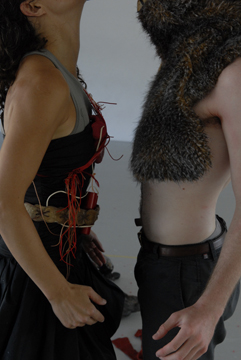
You have worked with Eran Shanny, who performs with you in LOVE FIRE, for many years. Do you feel that he brings a particular presence to the work that creates an affinity between the different pieces?
YG: Ideally, no. It changes…Yes, he brings something specific to the work, but my intention is to create a situation in which new dimensions of his presence can emerge. There is a relationship to a particular language over time for many years, and the language of the works comes from my body. I am working within a certain aesthetic world through my body, yet the people I work with have an influence and bring their own interpretation, their emotional interpretation and I encourage that, I don’t just encourage it I also train them to do that.
Is this training something very structured?
YG: It has developed over the years through my work. It began with my collaboration with Itzik, who is my partner, who comes from the theatre. We experimented with bringing theatre exercises into dance. To connect the performance personally to the movement, like connecting an actor to the text, but to movement. It began as an exercise to create more depth within the movement and developed into a way to create new material.
When I work with people I devote some of the time to developing their performance abilities. In Singular Sensation I began with a workshop whose purpose was to become acquainted with my work methods. Because I am not a conventional dance company I don’t work that way. We don’t meet each morning to take a class together there are other things that happen. Training is not just what takes place before working on a particular piece, or in the morning when you warm up. Training is what happens in the way you respond to people and guide them to what you want. If I am searching for a certain quality I try to create exercises that will open up and perhaps awaken this quality.
At some stage it is less training…with Eran that is more where we are now in the communication between us. It’s something very intuitive, there is a flow of understanding and searching.
Your work with Itzik Giuli is another long term partnership, in life and work; he is described in the credits as the dramaturg for your works, something that is not typical in dance. Could you elaborate on that?
YG: The mode of cooperation changes constantly. Sometimes it is dialogue in the studio; sometimes the conversation begins well before the work itself. There is a curiosity that surrounds something…He responds to what he sees and brings other referents and topics to discuss. I build the journey that happens on the stage together with him. In the studio its mostly me with the dancers. In a work like Singular Sensation I can observe from the outside so it was mostly me. When I am dancing, as in this work…it’s Itzik. It changes a lot according to what is right and works for the piece. It’s very comfortable, [to work with] someone that you trust. Sometimes we don’t agree, we don’t always see things in the same way. We each fight for our individual vision. It’s comfortable, and it feels right, but more than that it’s interesting, it excites curiosity. It keeps it alive, challenging. I like a challenge, to feel that I’m challenged by something each time. I like that feeling.
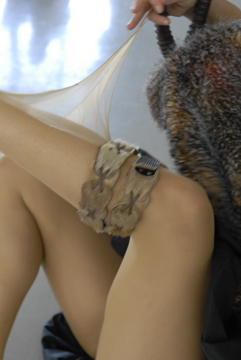
There are recurring objects in your works…
YG: Oh yes? What, for instance?
The ichs [Hebrew for ‘yucky’] jelly.
YG: Yes, but that was just in Singular Sensation.
It’s the color red, and the ichs of the jelly and the puncturing – was that Ilaya with her nails in Singular Sensation?
YG: No, that was the oranges with the scissors.
Oh yes, the scissors too.
YG: Right…
That connects with the fur to I’m Mean I Am (2006).
YG: Ok, with the animal in I’m Mean. That’s interesting. In I’m Mean there was the blood…with Singular Sensation it really interested me to use the materials themselves, to further… to go deeper, to take the plastic dimension forward. To remember that the body is material at certain moments. It’s an image, it’s not a person. Of course it’s a person alive there on the stage and that is the beauty, but for a moment you can view it as an image. The plastic dimension always interested me even when it is only the body and I am very sensitive to it and in Singular Sensation I took it to another level.
Here even more so – the involvement with objects. The process was not ‘ok I need scissors and furs…It was a very associative process. First there was the animal then the furs, and scissors came from the image of sewing. Associations upon associations, and perhaps these associations carry a certain weight from other works. In Singular Sensation, by the way, I also have stockings, not me but…
Yes, that is stretched between the two dancers. I’ll take you back further, you put on a belt of explosives in LOVE FIRE, and that is in Alina’s Wall.
YG: I don’t know, perhaps these are subconscious images that occupy my mind. I feel that connections are created between many different associations. My dance works become part of my history, my private history. I have been creating dance for more than ten years now. It really is a kind of closed world in which one can have internal dialogues.
In LOVE FIRE it was interesting to create from a place where I was not the initiator [the specific commission was to relate to the waltz], and to continue to work with the expectation, the sense of what is expected from me. That interested me and that is one layer. Then the waltz was another layer. The waltz brought its own content of a woman and man. The image of the waltz is a woman and man swirling around one another; it is a kind of grandeur. Things that we connect to Europe, something classic – to be civilized, our idea of being ‘cultured’. It interested me to try to connect with a cultural European dimension. On one hand, I am connected to it, genetically, culturally, but essentially, I don’t live there I live here and my associations, even my associations from childhood are completely different.
There is a kind of fantasy. A fantasy that we collect from many different places we don’t even remember their origins, but these fantasies become a part of us, they become ours.
It is connected to our concepts of relationships. For me it touched on places that were very difficult to connect with, that I had not dealt with previously in my work. A more romantic place…
Because we receive so much information from outside – from the media, television, movies, the internet, there are images that we perceive to be our own experiences, but when we experience them, they are sometimes actually already internalized within us as images. That is what I discovered in this process. There is a difference between being cynical about something and experiencing it as if it is yours but it is actually a stereotype of something that is supposed to happen.
A man and a woman, each trying to impress the other, seduction, romance, contending with post-romance and the animal becomes an allegory for contending with passion. The thing with the waltz and the desire that it will be all-encompassing and sweep us away…everything we want from a relationship…and the animal is a reminder.
There are many layers to the work. Associations with Europe, romantic fantasy, and the music itself.
Could you discuss your collaboration with the visual artist Yochai Matos on this project?
YG: I had an artistic dialogue with Yochai dialogue for many years, sort of in passing. He was interested in my work and I was interested in his work. He wanted to respond to the work, to come onstage after the end of the performance, like at the end of Singular Sensation when there is all this stuff on the stage, to take pictures, to document. We went through a complex process, exploring what it means to respond to a work and ultimately returned to the original idea of his arrival onstage after the performance is over.
Then we began a process of developing a character, a sort of up-graded Yochai Matos.
It makes me think of Deus ex machina
YG: Yes, yes, completely, it’s a lot of things – half Rocky Horror, half Star Wars. I love these references, we grew up on them. They are in our thoughts, our memories; we produce them in our fantasies. He is the response to the work, but he also creates a response, there is an installation in which we take part. There is the question – who is this person who responds? He brings his world [into the piece].
The fact that he performs adds another dimension. Its not his field (dance), like with the waltz, I took it upon myself to do something that does not feel at home. When we talked about it he talked about the street art he has done. It has a dimension of performance people look at him; it takes place within the public sphere. There was a connection for me to the question of performing, the desire to perform. These were all sorts of threads that were bound together through our dialogue.
The sewing in the beginning of LOVE FIRE gives a sense of piecing things together, to put on pieces, to connect and take apart -framing everything that is about to happen.
YG: Yes, and we’re preparing ourselves for the performance.
You talk about not feeling at home, yet you appear at the beginning of LOVE FIRE in a robe and slippers.
YG: Yes, it’s so Yafo. That’s the idea, I start with this Yafo. Then I dress Eran like a Prussian Prince, would-be prince, over a white T shirt. We’re constantly dressing and putting on costumes, there’s a lot of disguise in this work. Eran puts the horns on me and I am the Snow Queen. To put on a disguise and become someone else for the other person, that is also a dimension of the work, within the romance.
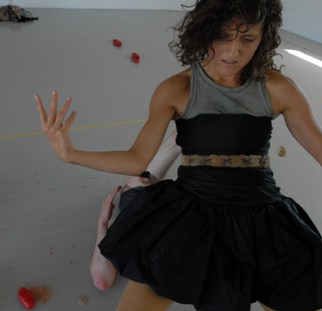
At certain moments in LOVE FIRE you seem to communicate very directly with the audience, is that an accurate perception on my part?
YG: Yes, and it interests me. It’s frightening and interesting and very emotionally exciting to have that dialogue in real time.
In some moments it feels like a kind of seduction.
YG: A little bit…there is that twist [seduction] and it’s part of the character I portray.
When you perform and create these characters, do you identify with the character?
YG: Yes, I do identify but part of the fun is to step out of my own skin.
Part of the fun of performing is not to be myself, to identify with the character, but it’s not me, not the way I see myself.
I remember after I’m Mean people told me ‘You were so exposed. You were so brave to show yourself truthfully’, but part of my freedom was the feeling of taking so many things to an extreme, but it’s not me. That is what gave the freedom and the courage. But in order to be credible it has to feel exposed, to feel… call it real even though that is a problematic word, after all you are playing with illusion.
I love that border between truth and lie, it’s happening and it’s not really happening.
That is what I love about theatre. It is real. It is an event that takes place in time, what takes place there actually takes place, it happened, you saw it. When Eran disembowels the animal from his perspective it is real, but the animal is not real. Although some people in the audience experience it as real. I love to be involved with that – things that are very clearly fake and yet still feel that something is happening.
It interests me terribly…You come to the stage as an actor and say this is not real. But it is real. It is part of your life. You were up on the stage and you were that person.
In my works you can see things like that, you see that it is an actor, but the actor is very credible. The work has to touch a personal truth, this fuzzy border where the distinctions are blurred. I love it, it’s interesting.
How do you create that illusion?
YG: It connects to what I said at the beginning – through techniques of acting, to approach the material from your personal individual experience, to see where it connects.
It’s interesting, because it’s the mind, the thought…to change the thought from within.
That’s what interests me – the mental exercise – it captures me. Not only instincts, they exist on one specific level. That mental exercise – to be something, someone else, is interesting. It is also frightening.
Performance:
Wednesday, January 12, 2011 at 22:00
Suzanne Dellal Hall
Tickets: 03-5105656, www.suzannedellal.org.il
Choreography: Yasmeen Godder
Co-Artistic Director and Dramaturgy: Itzik Giuli
Creating Performers: Yasmeen Godder, Eran Shanny
Guest Artist: Yochai Matos
Music: Johann Strauss – The Blue Danube; Jean Sibelius – La valse triste; Dimitri Shostakovitch – Valse n°2; Arnold Schoenberg – Valse de Chopin from Pierrot Lunaire, Op. 21; Frederic Chopin – Opus 70 in G-flat major; Pyotr Tchaikovsky – Valse Sentimentale; Aram Khachaturian – Waltz from Masquerade Suite.
Costumes and Props: Inbal Leiblich, Yasmeen Godder, Eran Shanny
Animal Construction: Inbal Leiblich, Zohar Gotesman
Lights: Uri Rubinstein
Sound editing and design: Eyal Shindler
Production: Shira Korona
Administration and Touring: Guy Hugler
Length: 65 min.

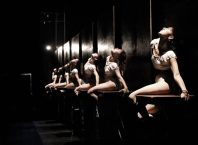
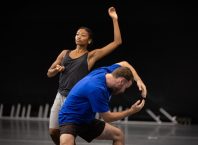
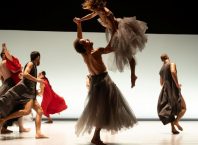
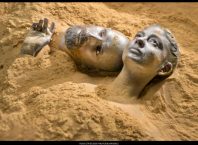
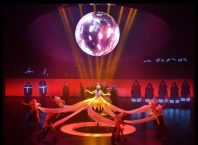
Comments are closed.